Apogee is an American company created in 1985 and located in Santa Monica, California. It started by manufacturing anti-aliasing filters for high-end Sony and Mitsubishi digital recording systems designed for CD production, in order to improve their sound quality, and the brand rapidly became leader in this field.
In 1997, Apogee launched the first 24-bit multichannel audio interface, and more recently, they were behind the first professional systems designed for music production on Apple computers.
This brand, which we didn’t know existed thus far, has therefore been on the frontlines for the evolution of digital music, and they quite naturally ended up manufacturing a DAC with headphone amplifier, called Groove, that we now offer you to discover in this testing ground.
||About the Apogee Groove DAC|| |Type:|Autonomous digital-to-analog converter with headphone amplifier| |Function:|Transforms digital audio data into analog signals and amplifies them| |Conversion:|Up to 24 bits at 384 kHz,
DSD64, 128 and 512| |Converter:|ESS ES9016| |Digital inputs:|Micro USB| |Audio outputs:|Headphone on 3.5mm Jack| |Power output:|225 mW/32Ω / 40 mW/600Ω| |Dimensions (L x H x P):|30 x 16 x 95| |Weight:|2.01 oz (57 g)| |Design/Manufacturing:|USA / USA| |R.R.P.:|Around 400 euros (black version),
600 euros (anniversary editions)| |Contact:|FreeVox.fr|
Presentation
Even if it doesn’t try to be the smallest in its category, the portable Apogee Groove DAC inspires confidence with its solid die-cast aluminum alloy whose top side is equipped with two big rubber volume knobs and three multiple indicator multicolored LEDs.
In its basic version, this DAC has a satin black finish and two deluxe versions, Champagne and Silver, have been added by the brand to its catalog for its thirtieth birthday.
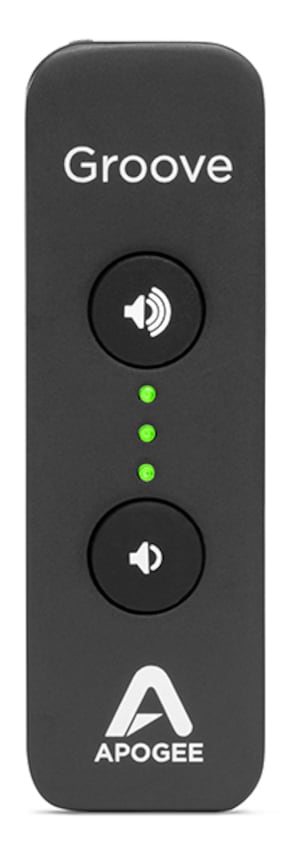
When the device is ready, the lower LED lights blue, and when you turn up the volume, one, two or three of these LEDs light purple (and inversely when you turn down the volume), while during playback they work as a dynamics indicator by shining green, the red lighting of the top LED signaling a clipping, encouraging you to turn down the volume.
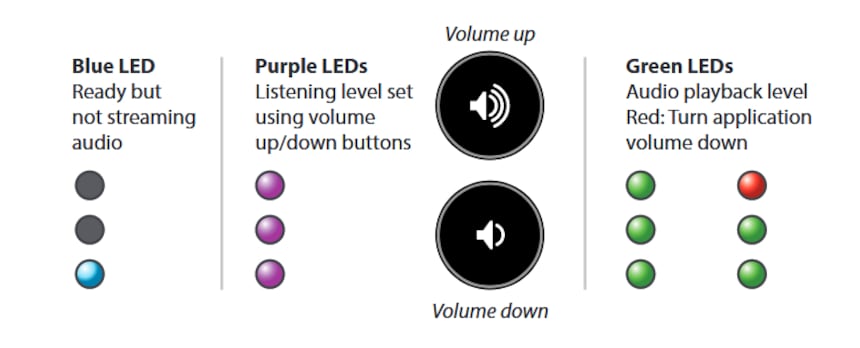
You link the device to a computer through a micro USB socket located on the top of the box and besides which you’ll find a system to hook a strap. The 3.5mm headphone Jack is located on the opposite side. The lower side of the box is equipped with a rubber nonskid pad which will prevent it from sliding when put on a flat surface.
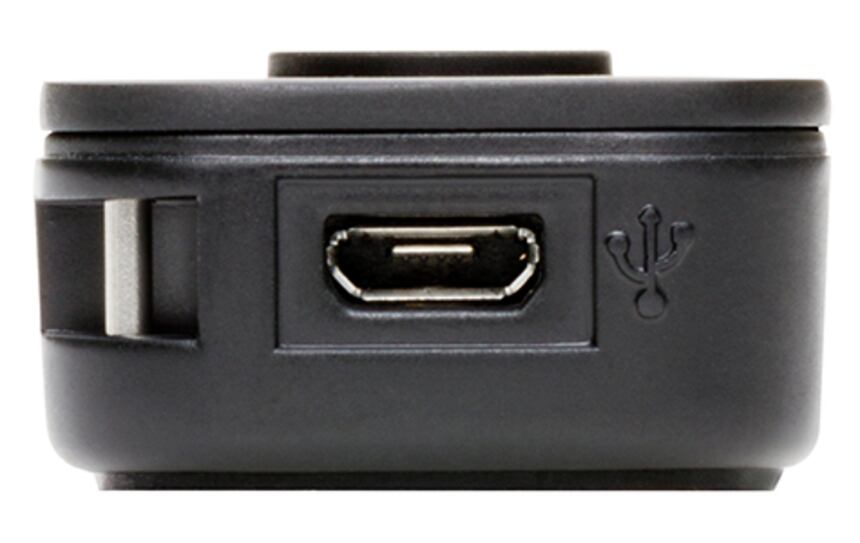
Manufacturing
On the top side of the small circuit of the Apogee Groove DAC, you’ll find the volume control keys, the three multicolored LEDs, quite a few transistors obviously used in the headphone amplifier as well as, opposite them, the USB processor, a XMOS 6U6C5 model with only one oscillator instead of the usual three—one for the master clock, and two for the synchronization with the digital audio signals.

The other side is more lavishly fitted out, since most part of its surface is devoted to the power supply. The digital-to-analog conversion is ensured by an ESS ES9016 chip which uses Hyperstream, a technology involving a 32-Bit recalculation at high frequency of each and every incoming digital signal, as well as the Time Domain Jitter Eliminator process. It includes eight channels used in groups of four on each stereo channel to improve the signal-to-noise ratio.

The analog signals coming from the conversion made by the ES9016 chip are then cleaned out by active filters using Texas Instruments OPA1642 low-noise operational amplifiers belonging to the SoundPlus series. The headphone amplification, which can be used with professional headphones with an impedance of 600 Ω, uses the proprietary technology Constant Current Drive that compensates acoustic, mechanical and electrical non-linearities of each headphone and also calls upon an Analog Devices AD8397 high output current operational amplifier.
Sound
Linked to our computer and used in conjunction with the Qobuz for Mac/PC application, the Apogee Groove DAC driving our Oppo PM-3 headphones has provided us with a very good sound restitution of Vivaldi’s Vespri per l'Assunzione di Maria Vergine performed by the Concerto Italiano conducted by Rinaldo Alessandrini.
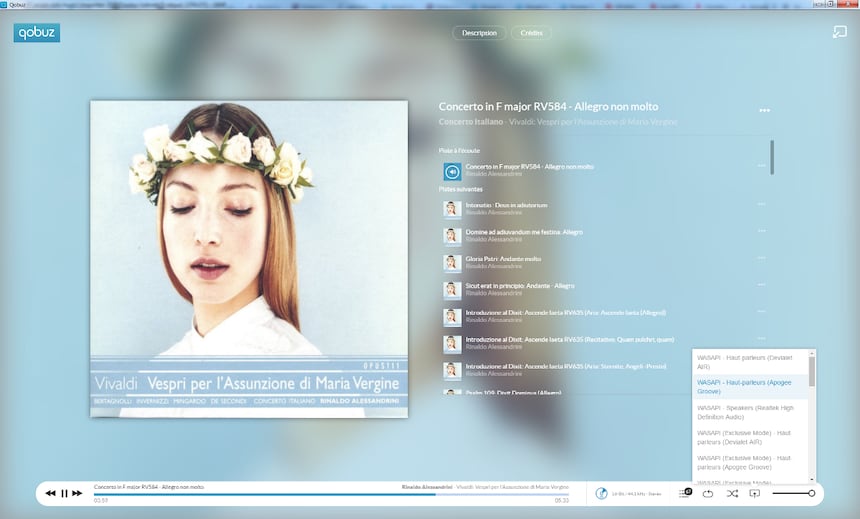
This DAC obviously doesn’t try to show off: it’s almost as if we don’t realize when listening to it that an ESS chip is used, because the treble keeps from overdoing things, as evidenced by the slightly restrained chords attacks. This Vivaldi, usually so virulent, displays with the Groove a slightly more tempered character, that isn’t unpleasant and is actually a bit more relaxing.
It’s also a slightly subdued reproduction that this Apogee Groove DAC offers us of Carl Orff’s profane cantata Carmina Burana performed by the London Philharmonic Choir and the London Philharmonic Orchestra conducted by Hans Graf, which is fine with us, especially when listening to the famous O Fortuna, whose powerful—or even scary—choruses and the thunderous orchestra can sometimes have a greater or a lesser impact, there are days like that!
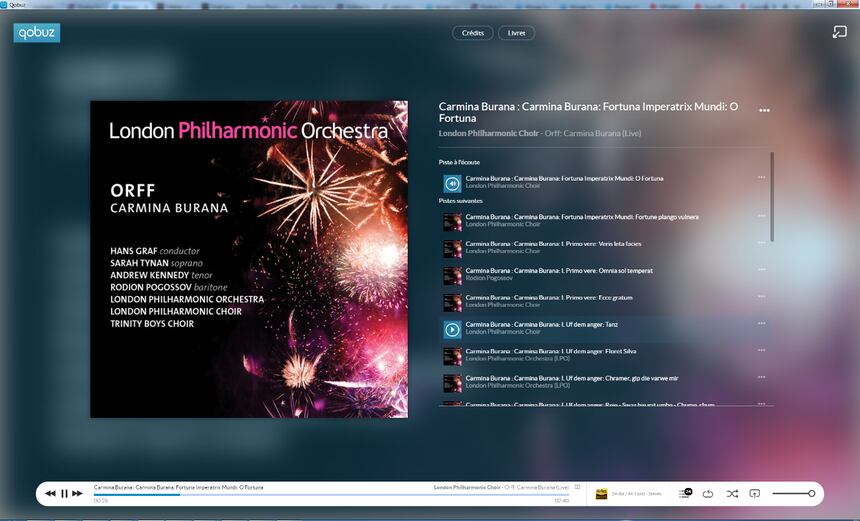
We’ll also note that the intensity and colors of the work stand out well—the famous Tanz gives us one of the most memorable examples of that—and the Apogee Groove DAC gives free rein to all its joy and good mood.
This is also a beautiful musical moment that this DAC provides us with the song Le Lac from Julien Doré’s album Le Lac, restituted with subtlety and finesse, highlighting the singer’s slightly hoarse voice and the subtle and graceful accompaniment. For that, we put it on repeat for a few listens.
To finish, let’s see the capabilities of this Apogee Groove DAC in relation to bass and power. We had noticed that this beast was getting hot, but it also has some power in reserve, and it willingly delivered powerful and controlled bass on the tracks North Star and Silence Space from the album Tale Of Us, and at very high levels, the bar graph’s three green LEDs stay on permanently, without the last one turning red—which means there’s still some energy in reserve!
To conclude, the Apogee Groove DAC is a carefully designed and manufactured device that offers a very high-quality sound reproduction, imbued with a certain softness, and its powerful headphone amplifier is able to drive many models.
We would like to thank Freevox.fr for lending us the Apogee Groove DAC.
Playback capabilities
On PC, with Foobar2000, we have been able to play DSD files up to DSD256 in PCM conversion at 176 kHz, and the results are even more impressive with USB Audio Player Pro on an Android tablet…
To follow everything happening here at Qobuz, join us on Facebook!


